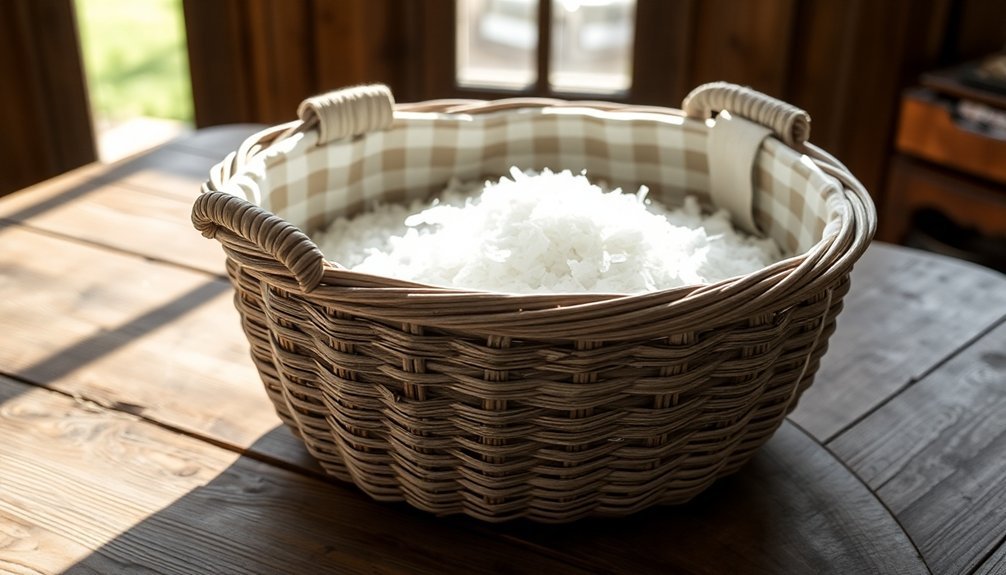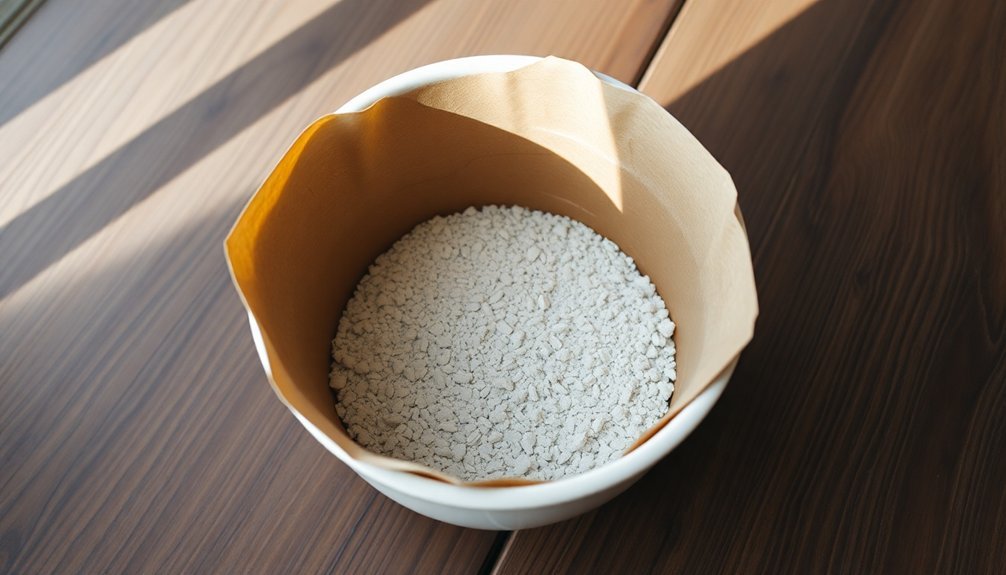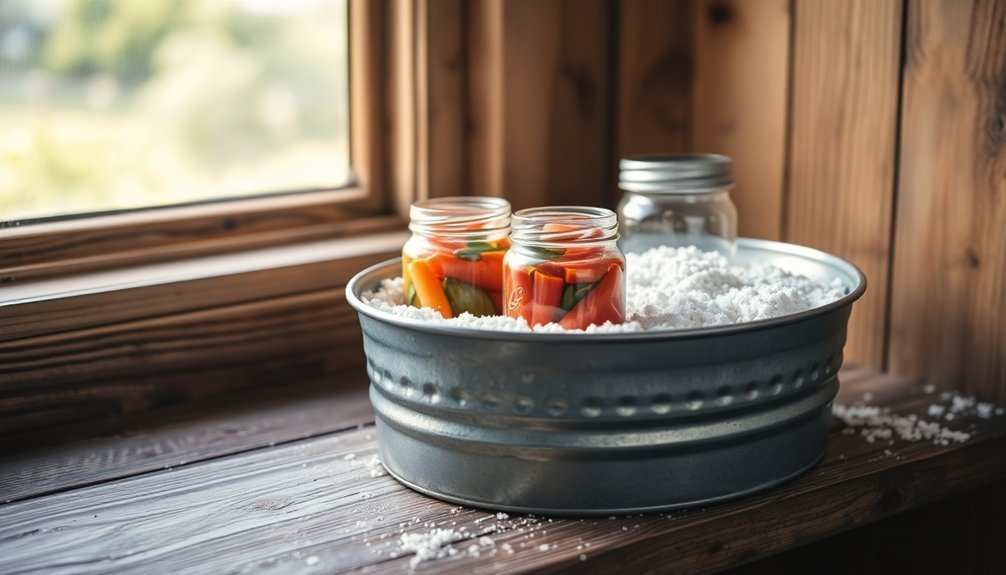For wood ash food preservation, you'll want to choose containers that allow proper contact between ash and food while maintaining ideal storage conditions. Traditional earthenware crocks offer excellent preservation with their thick walls and water seal system. Natural wood storage boxes provide stackable convenience and resist warping. Lined woven baskets, made from materials like seagrass or rattan, allow essential airflow while keeping contents cool and dark. Vintage clay pots excel at fruit preservation through controlled gas permeation. Skip paper-lined ceramic containers as they interfere with the preservation process. Understanding each container's unique benefits will help you master this time-tested preservation method.
Traditional Earthenware Crocks

For centuries, traditional earthenware crocks have served as reliable vessels for food preservation and fermentation. These thick-walled containers, made from stoneware or ceramic materials, come in various sizes ranging from 2 to 25 gallons to accommodate different preservation needs. Local farmers traditionally used six-gallon crocks for storing eggs in water glass solution throughout winter months.
You'll find these non-reactive vessels especially useful for fermenting vegetables like cabbage for sauerkraut and cucumbers for pickles. To use them effectively, you'll need to submerge your vegetables in brine and keep them weighted down with boards or stones. The unique water seal or gutter system prevents air from entering, creating the perfect environment for fermentation at temperatures between 60-75°F.
Beyond vegetables, you can use these crocks to preserve eggs in water glass solution or meat in brine with saltpeter. While they're excellent for long-term storage, you'll need to maintain them properly by regularly checking for surface scum and ensuring the water seal remains filled.
When your fermentation is complete, you can transfer the contents to mason jars for refrigeration. Remember to store your crock in a cool, dark place to maintain ideal preservation conditions.
Natural Wood Storage Boxes
While earthenware crocks offer traditional preservation methods, natural wood storage boxes provide a more versatile approach to modern food storage.
These boxes, crafted from sustainable materials like paulownia, mango wood, and bamboo, come with practical features such as handles for easy transport and sealed surfaces that resist stains and warping. The open-top design ensures you can always see and easily access your stored items.
You'll find these boxes particularly useful in your kitchen, pantry, or any space where you need organized storage.
They're stackable, making them perfect for maximizing cabinet space, and you can use them to store everything from dry goods to condiments.
The wood's natural construction guarantees your food items remain safe, as these materials are non-reactive and free from harmful chemicals.
To maintain your wood storage boxes, simply dust them regularly with a soft cloth and avoid harsh cleaners that could damage the wood's natural oils.
If you need deeper cleaning, use a damp cloth but dry immediately to prevent moisture damage.
You'll want to keep them away from direct sunlight and heat sources to preserve their integrity.
For extra protection and longevity, you can occasionally treat the wood with food-grade mineral oil.
Lined Woven Baskets

Among traditional food preservation containers, lined woven baskets stand out as versatile and eco-friendly options for storing wood ash-preserved foods. Made from natural fibers like seagrass, rattan, and water hyacinth, these hand-woven containers offer durability while maintaining a rustic aesthetic that complements any interior. The ancient furniture-making method of wicker construction ensures these baskets can withstand years of use in food preservation.
Key benefits of lined woven baskets for ash preservation:
- They're lightweight yet sturdy, making them perfect for layering food items with sifted wood ash.
- The natural fiber construction allows for proper airflow while maintaining cool, dark conditions.
- Their spacious design accommodates multiple layers of preserved foods, maximizing storage efficiency.
To use these baskets effectively, you'll need to line them with paper before adding a layer of sifted wood ash.
Place your food items, such as tomatoes or eggs, in layers, covering each layer with ash as you go. The ash acts as a natural pest deterrent while extending food viability for several months.
You'll find these baskets particularly effective for preserving tomatoes, which can last up to three months when properly stored.
Remember to keep your filled basket in a cool, dark place for ideal preservation results.
Vintage Clay Pots
Vintage clay pots represent one of history's most ingenious wood ash preservation methods, dating back to prehistoric Afghanistan.
You'll find this ancient technique, known as "kangina" or "treasure" in Dari, particularly effective for preserving grapes and other fresh fruits for up to six months or even years.
When you're working with these clay pots, you'll need to create them using clay-rich mud mixed with straw.
The containers consist of two bowl-shaped pieces that you'll need to bake in the sun before sealing with additional mud.
Each pot can hold 1-2 kilograms of fruit, and you'll want to guarantee the fruit isn't bruised before storage.
The preservation mechanism works through the clay's unique properties.
You'll notice how the container creates an airtight seal while allowing gradual gas permeation.
This maintains ideal oxygen levels and creates a high CO2 concentration that suppresses fungal growth.
The clay's moisture-absorbing qualities also help prevent bacterial growth.
While these pots are heavier than modern alternatives, you'll appreciate their eco-friendly nature and effectiveness, especially with thick-skinned grape varieties like Taifi or Kishmishi.
Paper-Lined Ceramic Containers

Despite their popularity in modern food storage, paper-lined ceramic containers aren't suitable for wood ash preservation methods. The paper lining and ceramic coating create barriers that interfere with the direct contact needed between wood ash and food items, compromising the preservation process.
While these containers excel at everyday food storage, they simply can't provide the right environment for traditional wood ash preservation.
- The paper lining would absorb moisture and deteriorate when exposed to wood ash, potentially contaminating your preserved foods.
- Ceramic coatings prevent the necessary interaction between the wood ash and food items, which is essential for proper preservation.
- These containers don't offer the same time-tested benefits as traditional stoneware crocks, which have been proven effective for generations.
You'll want to stick with traditional stoneware or earthenware crocks for wood ash preservation.
These vessels allow for proper ash-to-food contact and maintain the dry, sterile environment that's vital for successful preservation.
They're specifically designed to handle the unique requirements of wood ash storage, including the need for complete ash coverage and protection from external moisture.
Don't let modern container innovations tempt you away from time-tested preservation methods.
Frequently Asked Questions
Can I Reuse Wood Ash for Multiple Batches of Food Preservation?
You shouldn't reuse wood ash for food preservation since it may have absorbed moisture and contaminants from previous batches. Instead, use fresh ash each time to guarantee the best preservation and safety of your food.
How Do I Know When Wood Ash Has Gone Bad?
You'll know your wood ash has gone bad if it's clumpy, has a musty smell, shows signs of moisture, or has lost its fine, powdery texture. Bad ash also appears darker and feels damp.
Will Wood Ash Preservation Work in Humid Climates?
You'll face challenges preserving food with wood ash in humid climates. It's possible but requires extra care – use airtight containers, thoroughly dried ash, and store in cool, dry places to prevent moisture absorption.
Can Wood Ash Containers Be Stored Outside During Winter?
You can store wood ash containers outside during winter if they're protected from snow and rain. Place them under a covered area, elevated on cement or brick, away from moisture and combustible materials.
Does the Type of Wood Used for Ash Affect Preservation Quality?
Yes, your wood choice greatly impacts preservation quality. You'll get better results using hardwoods like maple, oak, or hickory. Don't use softwoods or treated lumber as they won't preserve effectively.
In Summary
You'll find these five wood ash containers offer reliable ways to preserve food using traditional methods. Whether you choose earthenware crocks for their time-tested effectiveness or opt for natural wood boxes that complement your kitchen's aesthetic, each option serves its purpose well. Don't forget to properly line your container and keep it in a cool, dry place for best preservation results.





Leave a Reply